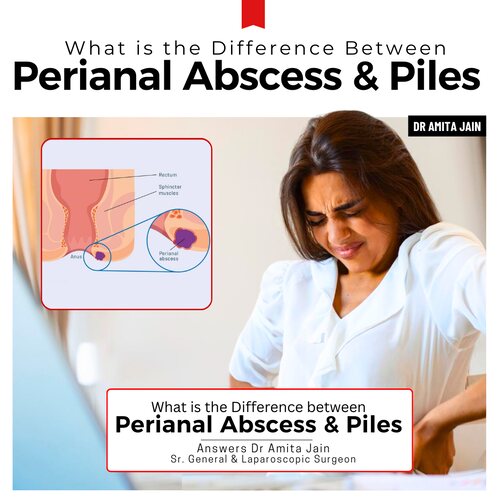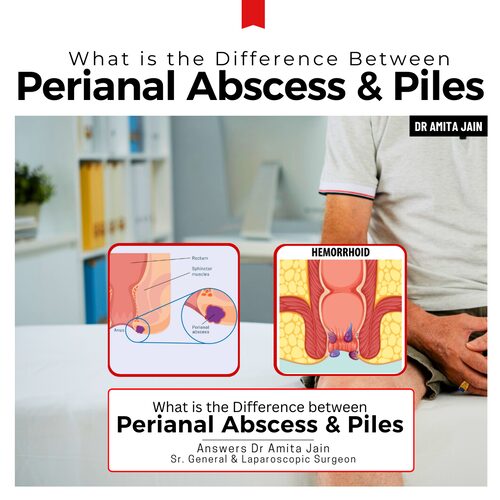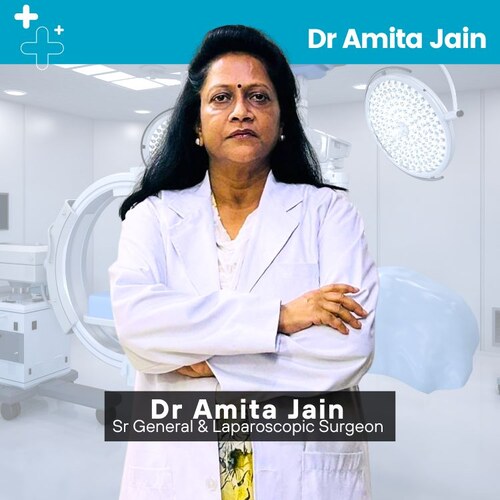When it comes to anal or rectal discomfort, many people assume it’s just piles (also known as hemorrhoids). But sometimes, the cause could be something entirely different, like a perianal abscess. While both conditions affect the same general area and may share some symptoms, they are very different in terms of cause, treatment, and urgency. Understanding the difference can help you get the right treatment and avoid complications.
Let’s break it down in simple terms, as shared by Dr Amita Jain, who is a leading Senior General and Laparoscopic Surgeon and specialises in painless laser surgery for piles.

What Are Piles (Haemorrhoids)?
Piles are swollen and inflamed blood vessels in the last part of the digestive tract. They can develop inside (internal haemorrhoids) or outside (external haemorrhoids). They’re quite common and are often caused by straining during bowel movements, chronic constipation, sitting for long periods, pregnancy, or a low-fibre diet.
Common symptoms of piles include:
- Bright red blood during or after a bowel movement
- Itching or irritation.
- A feeling of discomfort or swelling.
- A small lump or bulge.
- Pain (more common with external piles)
Piles are usually not dangerous, but they can be uncomfortable and annoying. Most mild cases improve with lifestyle changes, high-fibre diets, and topical treatments.
What Is a Perianal Abscess?
A perianal abscess is a painful collection of pus that forms near the last part of the digestive tract, usually caused by a bacterial infection. It occurs when a gland near the last part of the digestive tract, becomes blocked and infected. Unlike piles, which are related to blood vessels, a perianal abscess is an infection and needs immediate medical attention.
Common symptoms of a perianal abscess include:
- Severe, constant pain around the affected area.
- Swelling, redness, and warmth in the area
- Fever or chills
- Pus or fluid discharge
- Difficulty sitting or moving comfortably
A perianal abscess won’t go away on its own—it needs to be drained surgically to remove the pus and stop the infection from spreading.

How Are Piles and Perianal Abscesses Different?
- Cause:
- Piles: Caused by swollen or inflamed blood vessels in the rectal or anal area.
- Perianal Abscess: Caused by a bacterial infection leading to pus buildup.
- Type of Condition:
- Piles: A vascular condition (related to blood vessels).
- Perianal Abscess: An infectious condition (involves bacteria and pus).
- Pain:
- Piles: Usually mild to moderate pain, mostly during bowel movements.
- Perianal Abscess: Intense, continuous pain that worsens with movement or sitting.
- Swelling:
- Piles: Soft, fleshy lumps.
- Perianal Abscess: Red, swollen, warm, and tender area often filled with pus.
- Discharge:
- Piles: May cause bleeding during or after passing stool.
- Perianal Abscess: May ooze pus or foul-smelling fluid if it bursts.
- Fever and General Symptoms:
- Piles: Fever is not a common symptom.
- Perianal Abscess: Fever, chills, and fatigue may occur due to infection.
- Urgency of Treatment:
- Piles: Often manageable at home with dietary changes, medication, or non-surgical methods.
- Perianal Abscess: Needs urgent medical drainage to prevent complications.
- Risk of Complications:
- Piles: Usually low risk if treated properly.
- Perianal Abscess: High risk if untreated—can lead to a fistula or spread of infection.
Both piles and perianal abscesses can cause pain and discomfort, but they’re not the same. While piles are generally harmless and treatable with home care, a perianal abscess is an infection that needs urgent medical attention. If you’re unsure which condition you’re dealing with, it’s always best to see a doctor early, especially if the pain is severe or you notice signs of infection.

Dr Amita Jain is one of the most experienced and highly skilled general and laparoscopic surgeons in Delhi and India. Known for her exceptional surgical precision and patient-first approach, she offers expert care across a wide range of procedures, using both open and minimally invasive techniques to ensure faster recovery and better outcomes. Dr Amita Jain holds 28 plus years of rich experience in Trauma and General Laparoscopic Surgeries (including Gallbladder stone removal, appendix removal, hernia repair surgery, piles and fissure surgeries). She was the Professor Surgery of at the Army College of Medical Sciences. In 1994 she was commissioned as Surgeon under the United Nations Mission in Congo. From 2020 to 2022, she worked with Bansals Hospital. Currently, Dr Amita Jain is the Sr. General and Laparoscopic Surgeon at Rainbow Children Hospitals, Malviya Nagar, Delhi.
As a top female surgeon in Delhi, Dr Amita Jain brings decades of experience, compassion, and a commitment to surgical excellence. She has undergone advanced training in trauma surgery and has successfully performed numerous complex procedures, including life-saving surgeries, vascular repairs, mangled limb reconstructions, and critical care surgeries. Whether it’s a planned surgery or an emergency situation, patients across Delhi trust Dr Amita Jain for her expertise, integrity, and results-driven approach to general and laparoscopic surgery.
Call Us at +(91) 882-6615301